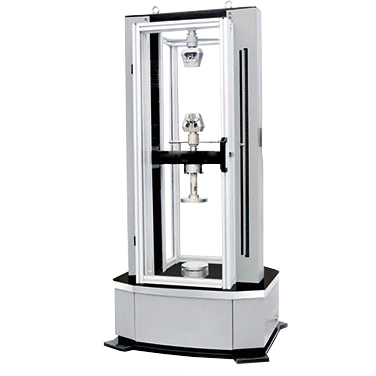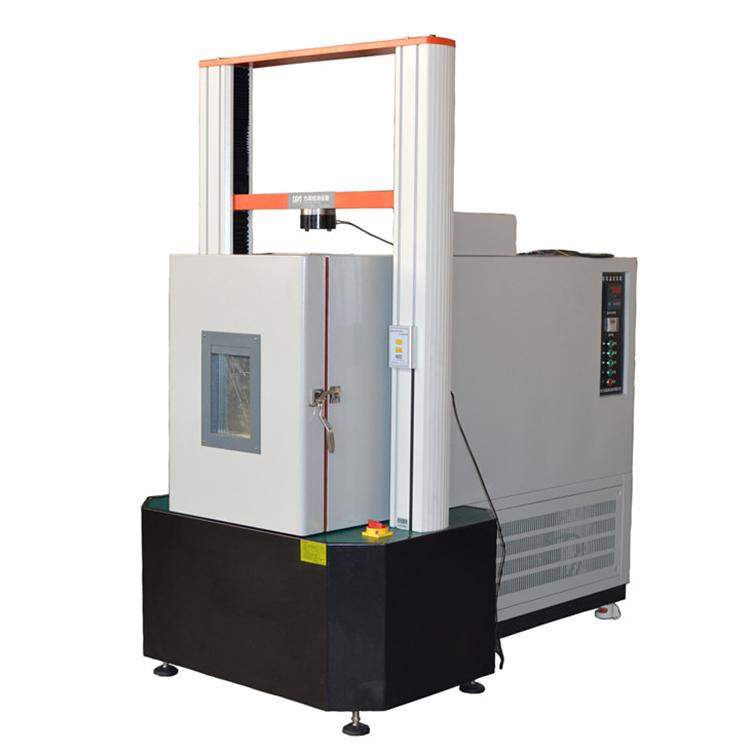What is the high temperature tensile test and low temperature tensile test?
In the material mechanics experiment, the most commonly used equipment is the universal material testing machine, which can perform tensile, compression, shearing, bending and other tests. There are many types of universal material testing machines. The following introduces the structure, operation procedures and precautions of the commonly used hydraulic universal material testing machine and electronic universal material testing machine.

application
Tensile testing machines are widely used in metrology and quality inspection; rubber and plastics; metallurgical steel; machinery manufacturing; electronic appliances; automobile production; textile and chemical fiber; wire and cable; packaging materials and food; instrumentation; medical equipment; civil nuclear energy; civil aviation; high Institutions; scientific research laboratories; commodity inspection and arbitration, technical supervision departments; building materials and ceramics; petrochemical and other industries. The tensile fixture is an important part of the instrument. Different materials require different fixtures, which is also an important factor for the smooth progress of the test and the accuracy of the test results. Tensile testing machines are widely used in various materials such as hardware, metal, rubber and plastic, footwear, leather, clothing, textiles, insulators, wires, cables, terminals, etc. to test their tensile, tearing, peeling, compression, The research and development, inspection and testing of bending and other materials are fully functional and widely used. Tensile testing machines are electronic, hydraulic and electro-hydraulic servo.

High temperature tensile test
The high temperature tensile test is a tensile test performed at a high temperature above room temperature. In the high temperature tensile test, in addition to stress and strain, two parameters, temperature and time, should also be considered. Temperature has a great influence on high temperature tensile properties, so the control requirements for temperature are very strict. The sample is generally heated by an electric furnace, and the working space of the furnace should have enough uniform heat, and the temperature should be automatically controlled by an instrument.
Basic nature
If a metal material works at a high temperature, and this temperature will not cause the material to creep, or although the temperature may have creep, but because the working time is very short, the creep does not play a decisive role. In the above two cases, the performance measured by short-term tensile force at high temperature becomes an important index to measure the mechanical properties of the material. Sometimes in order to determine the hot working process, it is also necessary to determine the short-term stretchability of the material at the hot working temperature.
In order to ensure the axial force and reduce the size of the chuck, the high temperature tensile specimen is easy to install the extensometer. The head of the cylindrical specimen shall be connected by a thread; the head of the flat specimen shall be connected by a pin. The high temperature extensometer usually has three parts, namely the clamping part connected with the shoulder of the sample, the extension rod which transmits the deformation of the sample to the outside of the furnace, and the transducer for measuring the deformation outside the furnace.
variable control
In the high temperature tensile test, the time of applying force to the sample, that is, the tensile speed, has a significant effect on the tensile properties. For this reason, the tensile speed of the sample must be controlled within the specified range during the high temperature tensile test. It is stipulated in the national standard that when measuring the non-proportional tensile strength and yield strength, the strain rate within the gauge length of the specimen during the yielding period should be within the range of (0.001~0.005)/min, and a constant value should be kept as far as possible.
When the strain rate cannot be controlled, the stress rate should be adjusted to keep the strain rate within 0.003/min in the elastic range, but the stress rate should not exceed 300MPa/min. An intermediate strain rate was used for the arbitration test. After yielding or when the specified non-proportional tensile strength and yield strength are not measured, the strain rate remains constant between (0.02 to 0.20)/min.
Usually a thermocouple is used as a temperature sensor to detect the temperature of the sample. The hot end of the thermocouple is tied with asbestos rope and attached to the working surface of the sample. The cold end is led out of the furnace and placed in ice water or in the zero compensation device, and its temperature deviation should not exceed ±0.5 degrees Celsius. During the high temperature tensile test, the accuracy of the temperature measuring instrument should not be lower than 0.1, and the accuracy of the temperature recorder should not be lower than 0.5%.
Test analysis
The performance indicators specified in the high temperature tensile test of metal materials are basically the same as those in the normal temperature tensile test, but generally the four performance indicators of tensile strength, yield strength, elongation after fracture and area shrinkage are measured. Due to the high temperature and short time tensile test, the length of the load duration has a significant impact on the tensile properties. When the short-time high-temperature tensile specimen is quickly broken, the tensile strength value increases significantly.
Load Duration Effect
The same is true for the yield point or the specified non-proportional elongation stress. Therefore, the national standard strictly limits the tensile speed in the high temperature and short time tensile test. The maximum allowable strain rate of the sample is only 1/20 of that in the normal temperature tensile test. It is usually estimated that the duration of the load for a tensile test should not be less than 15~20min. This must be strictly observed during the test.
The measurement methods of several major indexes of the short-time tensile test at high temperature are basically similar to those at normal temperature. With the change of temperature, the change trend of the four indicators
Variation of mechanical properties of low alloy steel with test temperature
The low alloy steel shows a peak of tensile strength at about 200~300℃, and correspondingly, the plasticity indexes δ and ψ also show a trough in the same temperature region. This is related to the blue brittleness of the material in this region. As the alloying element increases, this peak shifts to the right and occurs in the higher temperature region.
Low temperature tensile test
The low temperature tensile test is a tensile test performed at a low temperature below room temperature. In the low temperature tensile test, the sample and the upper and lower chucks are immersed in a low temperature tensile tank filled with gaseous or liquid refrigerant, and the sample can also be cooled by the fine-hole jet cooling method.
During the test, the sample should be kept at the corresponding cooling temperature for a long enough time. When a liquid cooling medium is used, the holding time should be no less than 5 minutes; when a gas cooling medium is used, the holding time should be no less than 15 minutes. The measurement of low temperature medium temperature usually adopts low temperature thermometer, low temperature thermocouple and related automatic recording indicator.
The refrigerants used in the low-temperature tensile test are usually ice, solid carbon dioxide (dry ice), liquid nitrogen, liquid helium, liquid hydrogen, etc. The tempering agent usually uses sodium chloride, calcium chloride, amine chloride, ethanol, chloroform , petroleum ether, etc.